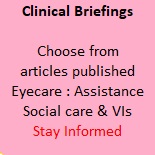Ophthalmology and OMPs
World-first for new AMD treatment procedure

World-first for new AMD treatment procedure – benefiting patients and the health service
An NHS patient has become the first person in a real-world setting to benefit from a new device, OcuClick, that ensures precise dosing of a medication, Eylea 8mg, for wet age-related macular degeneration (AMD).
 The groundbreaking use of the syringe by Professor Richard Gale, an internationally recognised ophthalmologist and AMD expert, was done at the Newmedica Lincolnshire eye clinic and surgical centre that delivers NHS services.
The groundbreaking use of the syringe by Professor Richard Gale, an internationally recognised ophthalmologist and AMD expert, was done at the Newmedica Lincolnshire eye clinic and surgical centre that delivers NHS services.
‘This fully approved device not only ensures the correct dosage every time but also reduces the time patients spend in the injection suite. That is better for patients by improving their experience,’ says Professor Gale, who has worked with syringe and medication manufacturer Bayer to educate other consultants on its use.
‘Ultimately this innovative new device will enable more patients to be treated for this life-impacting condition in the same allocated time. This is important because around 40,000 people are diagnosed with wet AMD every year in the UK, and patients require regular injections. The ability to deliver all the injections required is a challenge.
‘This innovation provides a more efficient treatment method and so is good news for the NHS, costing them no more money, while potentially enabling more patients to be seen.’
The pre-filled syringe contains a medication called Eylea 8mg, which is also used to treat diabetic macular oedema. It has undergone extensive clinical trials and studies, and Professor Gale is proud that his clinic is the first to use it in a real-world setting in support of the NHS.
‘It’s great for our patients and great for our service. It shows that we are at the forefront of innovation and bringing that to our patients in a very timely manner,’ he says. ‘We’ve now started using this device for all our wet AMD patients being treated with Eylea 8mg.’
Traditionally, AMD treatments involved drawing up medication from a glass vial and manually measuring a tiny volume, typically 50 microlitres, to be injected into the eye. This method requires careful visual judgment to ensure the correct dosage, which could be time-consuming.
‘The new device, however, changes the game by pre-filling syringes with the exact amount of medication needed – 70 microlitres,’ explains Prof Gale. ‘This eliminates the need for manual measurement, ensuring that each dose is accurate and consistent. It locks in the precise amount required, providing confidence in the treatment’s effectiveness.’
He also says it supports broader healthcare goals for the NHS in England as set out by Health and Social Care Secretary Wes Streeting. ‘Newmedica is providing a patient-focused community service that offers greater efficiency for the health service – which in turn supports the prevention agenda by protecting patient’s remaining sight with timely treatment.’
























